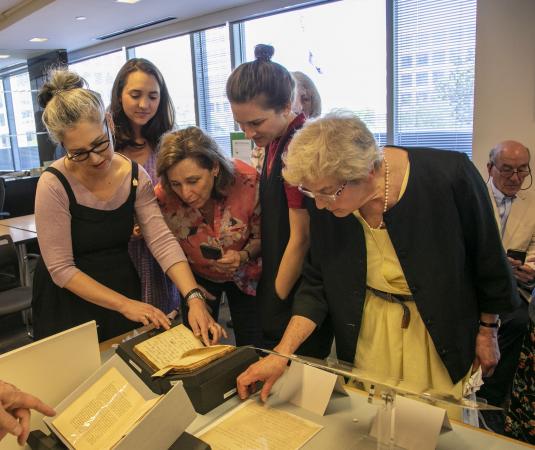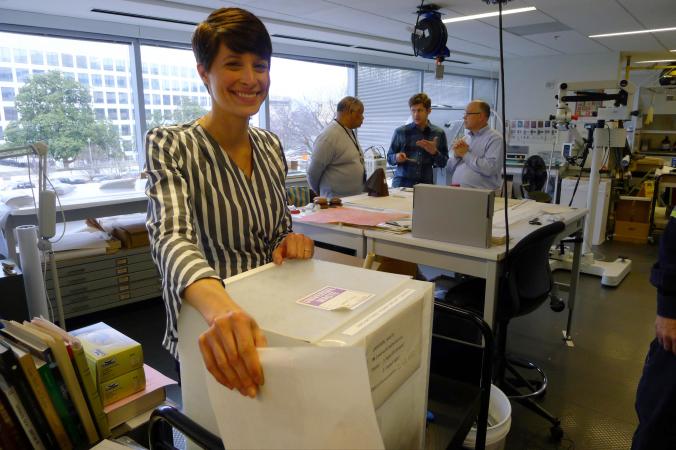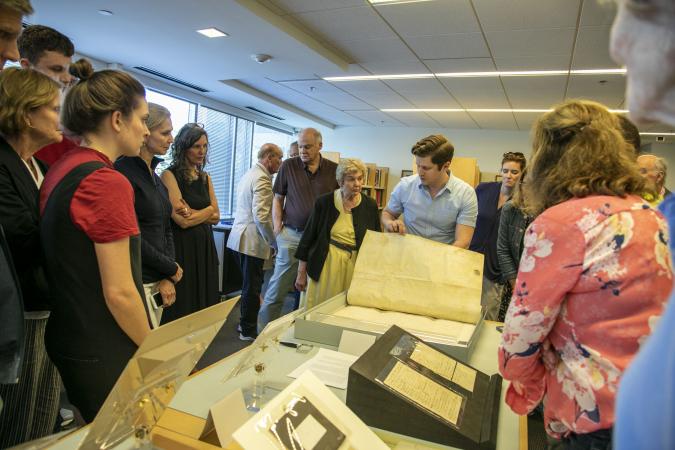In 2020, our top blog post of the year was “What Our Experts Want You To Know About Digitization.” Archives staff basically explained why not everything in our collections is online and just how much work goes into the process of digitization. With so much great feedback from our colleagues in the field, we thought it would be great to ask our preservation team to answer some of our burning, often ignorant questions about their work just in time for Preservation Week.
Which collections do they prioritize? Where do they even start when considering how to treat an object? What are some of the biggest challenges they face? And why aren’t they always wearing white gloves like in the movies?!
Let’s hear from our preservation team, made up of conservator William Bennett, senior conservator Nora Lockshin, and preservation coordinator Alison Reppert Gerber.
What would you say is one of the biggest misconceptions about your work? What do we need to understand more clearly?
Alison: I think some of the biggest misconceptions about our field revolve around how we treat objects. The perception that our primary goal is to restore objects to their original state or that little regard is given to the types of treatment methods we use is often perpetuated in films, television, and other popular cultural venues. Whether it’s lemon juice being applied to a historic document to reveal a hidden message, or a rare painting being aggressively removed from its stretcher with no subsequent damage, these images undermine the amount of thought that’s put into how we preserve objects. The truth is, especially in the recent past, there has been a significant shift in the field to support minimally invasive treatments that preserve not just the original elements of an object, but the elements that become part of an object throughout its lifetime, such as a fingerprint in the margin of a text or botanical specimens tucked between pages of a field notebook. Conservators not only preserve the object, but also preserve the story!
William: One of the questions that I see asked over and over is, “Why aren’t you wearing white gloves when you work, like they do on TV and in the movies?” Generally speaking, in book and paper conservation and preservation, we don’t wear gloves at all. The items we work with were meant to be handled and were designed for that purpose. The big exception would be for photographs, especially historic ones, where the image can be damaged by the oils on our skin. Even then, I would choose to wear recyclable nitrile gloves (I would also wear them to work with chemicals, to tone repair materials so they are visually integrated with damaged items, or working with moldy collections). Nitrile gloves fit close to the skin, and this assists with another key skill that white gloves would interfere with—our sense of touch. Wearing gloves adds a layer of distance between our fingers and our items, and preservation professionals rely on what our senses can tell us about the fragility and other qualities of the materials we work with.

What is something you wish your colleagues or researchers understood about your work in the digitization process?
William: One thing is that many people might assume that conservation will be supplanted or made redundant by digitization. If everything is digitized, there won’t be anything new to preserve, right? This forgets the fact that our existing physical collections need to continue to be cared for. A single intervention will hopefully last a long time, but it will need attention again in the future. It also ignores the fact that digitization offers access to content and visuals, but doesn’t convey information that can only be accessed from the original—the binding of a book, for example, or the materiality of lacquer discs and wax cylinders.
Nora: William touches on materiality and it is true that while imaging will help access, sometimes the interventions we are asked to make for that to happen pose an ethical challenge, such as choosing to intervene with an original structure or moving oversize parts (say a folded map or photograph to flat storage) to make it camera-accessible. If a work is inaccessible for a structural reason such as a book falling apart, or conversely doesn’t open well due to an overtight sewing, it makes sense to intervene—but we have to consider what comes after. Digitization is not a one-way street to the stacks—we may have many hours of work afterward to resew or rehouse the work so it can shelved, be safely served to the reading room, or used in an exhibition. We also have to document and decide on how much of a record to keep in our intervention, depending on how much the object is changed as a result. Our reference team does point the researcher to the digitized access copy, but that may not hold all the information they are seeking. Some may want to look at the back side (not always imaged), take measurements, or note some other physical process that is not captured in a largely two-dimensional view.
This next question I’m asking for a friend (me), what is the difference between preservation and conservation?
William: Often people want to make a hard distinction between preservation and conservation activities—certain actions are classified as one or the other, and strict segregation is kept between them. Preservation is a larger umbrella term covering all that we do, on a scale of intervention from the macro environment and processes to the individual item. Preventive conservation, where we try to keep damage from occurring by creating hospitable conditions (storage and climate controls, for example) is thought of as minimally interventive on one end. Conservation might occur in the middle, where increased intervening is necessary, like taking apart a book to fix damaged sewing, cleaning a manuscript, or mending a torn page. And on the other end is restoration, the most interventive activity, and which seeks to restore an item to its original state. Restoration can be a loaded term in the English-speaking preservation world. It carries connotations of going too far—trying to restore an earlier or original state is challenging because we can’t know for sure what that original state was. Even with perfect records. And even if we had the ability to perfectly restore an item, is it okay to disguise the damage that is part of its history? These are questions that fall into our professional standards.
That being said, different approaches will be taken by different studios and practitioners, and ideas about preservation vary from country to country, from institution to institution, and have to be adapted for the needs of the collections. Preservation professionals and conservation interventions are driven, ultimately, by the needs of the collection items and by the needs of the collector or repository.
Nora: More concepts to throw in the mix include aesthetic (or visual) reintegration, and virtual restoration. The former helps us consider what the viewer needs to see and understand the work as a whole, without hiding or trying to replicate exactly what is missing (lacunae). This might take the form of adding fill material in a way that physically supports and blends into the work, inpainting or even digitally printing replica tones or content, but in way that it can be distinguished from the original at close distance, and ideally, reversed in future by another professional. Aesthetic or visual reintegration may be appropriate for some works, but not necessarily so for all manuscripts or archives, from an evidentiary standpoint. The latter proposes using imaging technology to visualize the work as it was in the original, from available evidence, but without physical intervention that could change the nature of the work forever. Also, there is historic preservation, which tends toward the preservation of the built environment, place and sites. Libraries and archives support preservation and access to records that preservationists need to support their programs and facilities. Confused yet? I could go on and on here, but for the curious reader, there is lots of great debate out there in the Historical and Philosophical Issues in the Conservation of Cultural Heritage, and we continue to evolve as we in the museum world begin to hear and incorporate the ethical concerns of living cultures and stakeholders.

And while we’re clearing up terminology, could you put to rest, once and for all, why you’re a conservator and not a conservationist?
Nora: As to the endless debate of whether we are conservators or conservationists, I usually reply, “I love trees (and animals, and nature) too! But professionally, I work on things made from or about them.” We, at least in American English, are conservators. Conservationists are our colleagues who engage in scientific research to promote conservation of populations, species and habitats. After many letters requesting editorial corrections, the New York Times finally changed their editorial style guide to acknowledge that persons who work mainly on cultural heritage are conservators. We align with conservationists when we work to preserve and conserve records of biodiversity, cultural and personal histories, as we try to make our field more sustainable through lessening our impact by smarter application of technical standards and processes, and advocacy for better stewardship.
What does research look like on the preservation team, especially in considering how you treat an object?
William: Research for me is most usually into treatment methods. As part of our professional development we are constantly looking to see what new ideas and practices have been recently worked up, and whether we can utilize them to benefit our collections. When approaching a new project, especially one that is complicated or that might be outside of my experience, I start by seeing what my colleagues at the Archives, at the Smithsonian, and across the world might be doing.
Alison: As a preventive conservator, research is usually performed to better understand materials and their reactions to common agents of deterioration, such as humidity, temperature, housing enclosures, and frequent handling. The results from this research usually result in large-scale rehousing or digitization projects that affect the overall wellbeing of a subset of our collections, such as oversize documents or audiovisual collections.
Nora: Depends what you call research! I’ll describe some art historical research I am doing into a particular artist’s materials and methods in an answer to another question, below. It is important to note that conservation and preservation science is a whole field unto itself, in which many conservators participate in, or move into, using scientific methods to question, innovate, and examine effects of potential or past treatment material choices or preventive conservation actions. We have sponsored postgraduate fellows in conservation of museum collections for emerging conservators doing applied research and testing on archival materials and collections, and publishing their results. These have included studies on long term effects of deacidification on architectural records, preventive conservation and treatment of iron gallotannate inks in letterpress copying books, and effects of fire damage on optical discs and data recovery. Many museums, libraries and archives and entire centers focus on scientific research to advance our mutual knowledge. Career-wise, this is a terrific way to marry interest in materials science and art or cultural history, and its future.
What would you consider to be one of the biggest challenges that conservators face?
William: From my perspective, one of the biggest challenges that we face is based on resources. There is always a backlog of work to be completed, even with the greatest time management skills in the world, because historical collections are always in the process of deteriorating. Once a project is completed, there will always be another one to take its place. And these interventions are costly—mostly because of the amount of time, research, and effort that is needed to execute a treatment. Treatments are often complex and they evolve as the project gets underway. We can’t always predict how they will go and whether they will be successful, and an initial approach might have to be abandoned and a new one chosen.
Alison: To build off what William said, I find that prioritization is one of the biggest challenges we face—which resources, specifically lack thereof, can severely impact. Due to the sheer size of our collections, it’s impossible to provide individualized treatment to every item in our care. Much like digitization, priority is given to objects that have been deemed to have “high cultural value,” but it’s a constant struggle to even keep up with the needs of these collections. Determining what needs our attention is a constant conversation among staff and can get quite overwhelming!

Let’s end with a fun question. What has been your favorite preservation project at the Archives? Why?
William: This is an easy one—the Hungerford Deed. It’s on parchment, which I don’t often get to work with, it’s significant to our collections because it concerns the family of our founding donor, James Smithson, and it’s from the UK, and I’m a big Anglophile. It has offered me lots of opportunities to research the material culture of Smithson’s world, and I’m excited to be sharing what I’ve learned in a web exhibit that will launch later this year.
Nora: This is a hard one! I’ve worked on so many, but one that I keep returning to, when I can and with the help of interns, is the botanical paintings of Adelia Gates. Why we have them used to be a bit of a wonder, but over a decade, the collection has garnered consistent inquiries from researchers across the country from California to Arizona to Illinois and New York. Their inquiries and input have added to our knowledge and further revealed an extraordinary tale of this woman’s perseverance in the face of obstacles to travel the world in search of learning and botany—and her influence on more well-known botanists who are now reflected in our record. Hers tells a story of so many women who sought a life different than what was expected of them per their circumstances – a theme reflected by the American Women’s History Initiative and now the Smithsonian American Women’s History Museum. I look forward to continuing my research by visiting a related collection of her correspondence archived at Antioch College’s Olive Kettering Library in Ohio. I hope in those letters and diaries to find commentary on her purchase and use of materials, which may help in dating the undated works and will inform my conservation treatment approach for the most fragile ones, to enable full digitization at last.
Related Resources
- “What Our Experts Want You To Know About Digitization” with Marguerite Roby, Jessica Scott, Kira Sobers, and Heidi Stover, The Bigger Picture, Smithsonian Institution Archives
Produced by the Smithsonian Institution Archives. For copyright questions, please see the Terms of Use.

Leave a Comment